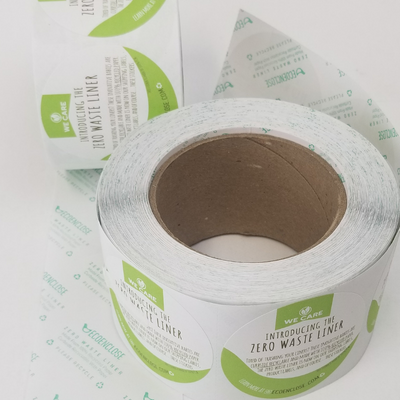Why Recycled, Recyclable Release Liners Are Important
Posted on Mar 28th 2019
What are Recycled Release Liners Important?
The day we announced this exciting new offering we got a lot of questions, especially this one.
What in the world is a release liner?
The truth is, you probably use release liners all the time - in your business and in your day-to-day life. A release liner is a material that carries a substrate with a pressure sensitive adhesive, until that adhesive is ready for its next step. It is sometimes called a backing or carrier.

Adhesive Bandages: Almost all adhesive bandages (with Band-Aid being the most common brand) have release liners on each side that protect the pressure sensitive adhesive until it is being used to treat a cut. An estimated 2 billion adhesive bandages are sold each year...meaning that 4 billion release liners are thrown away from bandages alone!
Feminine Products: Approximately 10 billion menstrual pads sold each year in the US, most of which are designed with a single, large release liner for each pad.
Medical Products: Every time you go to the doctor or hospital, chances are you are seeing release lines used all around you, typically for medical adhesives for IVs and other treatments.
Stamps: Approximately 40 billion stamps are printed each year, and the days of water activated (i.e. lickable) stamps are behind us, so the vast majority of these stamps come on a release liner roll or sheet.
Pressure Sensitive Tape: Masking tape, scotch tape, duct tape...these are all examples of pressure sensitive tape that “sticks to itself” on the roll, meaning that the top of the facestock of the tape acts as a release liner.
Envelopes and Mailers: Many envelopes and mailers use water activated adhesive. But some, especially larger, heavier duty mailers (like EcoEnclose recycled mailers) are made with a pressure sensitive adhesive and a release liner.
Labels: Imagine a standard sheet of labels such as those made by Avery Denison. These labels consist of a 8.5x11” release liner that is fully covered with facestock and the individual labels are die cut so they can be easily peeled off. When all of the labels are peeled off, the release liner, referred to as matrix, and remaining facestock is left behind. Sheet labels are just one type of labels on the market. Others include shipping labels (which are usually direct thermal or thermal transfer and come on rolls) and product labels (which also typically come on rolls).
Stickers: Stickers are everywhere these days! Kids get them at the doctors office, customers love getting them as freebies when they make a purchase, and many of us love decorating our water bottles, bumpers and laptops with them. Almost 250 million “I voted” stickers were produced in the last presidential election - a nod to the remarkable social power of sticker marketing. Online “make your own sticker” companies like StickerGiant produce 500 million to one billion stickers annually. More than 500 million bumper stickers are sold in the US annually.
Every time someone enjoys a sticker, they leave a little bit of release liner behind.
It is hard to fathom the sheer volume of release liners generated annually in the US. So yes, release liners truly are ubiquitous. Even if you’ve never heard the term before, you are likely dealing with release liners regularly.
What are release liners made of?
Traditionally, release liners are made out of a base substrate, such as supercalendered paper, glassine or PET. This base substrate is then typically coated with a layer of silicone or sometimes another type of release agent. The coating gives the liner it's release properties so the pressure sensitive adhesive stays on the surface that needs to be “stuck” to something else, and the release liner can peel away easily.
The vast majority of release liners are made with 100% virgin materials and are either unrecyclable or are extremely difficult to recycle. A standard silicone coated release liner must be sent to one of very few manufacturers in the US that has the equipment needed to separate the silicone from the paper, so the paper can be recycled.
Are there alternatives to virgin release liners?
Here at EcoEnclose, we consider recycled content one of the main tenants when developing a new product line. We are thrilled to offer an innovative Zero Waste Release Liner made with100% post-consumer waste and curbside recyclable with mixed paper.
Through a unique, patent-pending process, the facestock of our custom stickers and some of our shipping labels is coated with adhesive before being laid onto our Zero Waste release liner. This differs from the standard process in which a silicone-coated release liner is covered with acrylic adhesive and the facestock is applied to it.
The Zero Waste Label Release Liner is currently being offered on the following products:
Imagine the massive volume of release liners landfilled every year. Then picture all of this material made from recycled content and then easily recycled into something else. What an incredible vision!
EcoEnclose's Release Liner Take-Back Program
Most silicone-coated liners should be disposed of into your standard waste bin and sent to the landfill. However, we offer a unique Take-Back Program for the release liners used on our paper Standard Custom Stickers!
These stickers are delivered on silicone-coated release liners that are not curbside recyclable. These liners are very difficult to recycle, and are accepted by "Hard to Recycle" waste management facilities, label manufacturers and producers of alternative fuel sources. The Tag & Label Manufacturers Institute (TLMI) provides detailed resources for liner and matrix recycling here.
These liners are not recyclable with curbside pickup, and it is difficult for small and medium sized businesses to find the time and resources to recycle these liners and other hard to recycle waste they produce. So we are proud to announce that we can now recycle the liners for our customers.
- Save the mailer or box that was used to ship your stickers to your location.
- Remove the matrix (the material left on the liner after you use the stickers) or any adhesive material that remains on your liner.
- Collect your clean sticker liners and package them in your saved mailer or box.
- Contact us for a return shipping label. Include your name and address, and the dimensions and weight of the package.
- We send your liners to a TLMI recognized facility that takes back liners for reuse or fuel once your liners are shipped back to us.
Our Take-Back Program is structured to minimize waste. This is why we ask you to save and reuse your original packaging rather than shipping your liners back in new packaging. If you aren't able to save your original packaging, you can use any other packaging you have on hand, or contact us and we will send you a recycled and recyclable mailer.
Program Limitations:
- For EcoEnclose Standard Sticker liners only. Please do not send mailer liners.
- For US and Canadian customers only.
- For Canadian customers, this program is for full custom sticker orders of 1000 units or more.
- This program is for full custom sticker orders. We do not take back liners for sample sticker orders because the ecological benefit of recycling this small volume of liners is lower than the carbon footprint of shipping them back to our warehouse.


